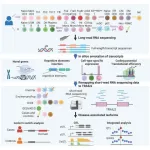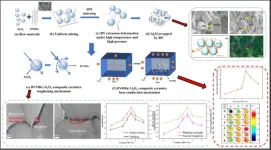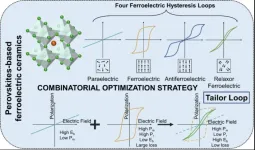(Press-News.org) About 2.5 billion years ago, free oxygen, or O2, first started to accumulate to meaningful levels in Earth’s atmosphere, setting the stage for the rise of complex life on our evolving planet.
Scientists refers to this phenomenon as the Great Oxidation Event, or GOE for short. But the initial accumulation of O2 on Earth was not nearly as straightforward as that moniker suggests, according to new research led by a University of Utah geochemist.
This “event” lasted at least 200 million years. And tracking the accumulation of O2 in the oceans has been very difficult until now, said Chadlin Ostrander, an assistant professor in the Department of Geology and Geophysics.
“Emerging data suggest that the initial rise of O2 in Earth’s atmosphere was dynamic, unfolding in fits-and-starts until perhaps 2.2. billion years ago,” said Ostrander, lead author on the study published June 12 in the journal Nature. “Our data validate this hypothesis, even going one step further by extending these dynamics to the ocean.”
His international research team, which is supported by the NASA Exobiology program, focused on marine shales from South Africa's Transvaal Supergroup, yielding insights into the dynamics of ocean oxygenation during this crucial period in Earth’s history. By analyzing stable thallium (Tl) isotope ratios and redox-sensitive elements, they uncovered evidence of fluctuations in marine O2 levels that coincided with changes in atmospheric oxygen.
These findings help advance the understanding of the complex processes that shaped Earth’s O2 levels during a critical period in the planet’s history that paved the way for the evolution of life as we know it.
“We really don't know what was going on in the oceans, where Earth's earliest lifeforms likely originated and evolved,” said Ostrander, who joined the U faculty last year from the Woods Hole Oceanographic Institution in Massachusetts. “So knowing the O2 content of the oceans and how that evolved with time is probably more important for early life than the atmosphere.”
The research builds on the work of Ostrander’s co-authors Simon Poulton of the University of Leeds in the U.K and Andrey Bekker of the University of California, Riverside. In a 2021 study, their team of scientists discovered that O2 did not become a permanent part of the atmosphere until about 200 million years after the global oxygenation process began, much later than previously thought.
The “smoking gun” evidence of an anoxic atmosphere is the presence of rare, mass-independent sulfur isotope signatures in sedimentary records before the GOE. Very few processes on Earth can generate these sulfur isotope signatures, and from what is known their preservation in the rock record almost certainly requires an absence of atmospheric O2.
For the first half of Earth’s existence, its atmosphere and oceans were largely devoid of O2. This gas was being produced by cyanobacteria in the ocean before the GOE, it seems, but in these early days the O2 was rapidly destroyed in reactions with exposed minerals and volcanic gasses. Poulton, Bekker and colleagues discovered that the rare sulfur isotope signatures disappear but then reappear, suggesting multiple O2 rises and falls in the atmosphere during the GOE. This was no single ‘event.’
“Earth wasn't ready to be oxygenated when oxygen starts to be produced. Earth needed time to evolve biologically, geologically and chemically to be conducive to oxygenation,” Ostrander said. “It's like a teeter totter. You have oxygen production, but you have so much oxygen destruction, nothing's happening. We're still trying to figure out when we've completely tipped the scales and Earth could not go backwards to an anoxic atmosphere.”
To map O2 levels in the ocean during the GOE, the research team relied on Ostrander’s expertise with stable thallium isotopes.
Isotopes are atoms of the same element that have an unequal number of neutrons, giving them slightly different weights. Ratios of a particular element’s isotopes have powered discoveries in archaeology, geochemistry and many other fields.
Advances in mass spectrometry have enabled scientists to accurately analyze isotope ratios for elements farther and farther down the Periodic Table, such as thallium. Luckily for Ostrander and his team, thallium isotope ratios are sensitive to manganese oxide burial on the seafloor, a process that requires O2 in seawater. The team examined thallium isotopes in the same marine shales recently shown to track atmospheric O2 fluctuations during the GOE with rare sulfur isotopes.
In the shales, Ostrander and his team found noticeable enrichments in the lighter-mass thallium isotope (203Tl), a pattern best explained by seafloor manganese oxide burial, and hence accumulation of O2 in seawater. These enrichments were found in the same samples lacking the rare sulfur isotope signatures, and hence when the atmosphere was no longer anoxic. The icing on the cake: the 203Tl enrichments disappear when the rare sulfur isotope signatures return. These findings were corroborated by redox-sensitive element enrichments, a more classical tool for tracking changes in ancient O2.
“When sulfur isotopes say the atmosphere became oxygenated, thallium isotopes say that the oceans became oxygenated. And when the sulfur isotopes say the atmosphere flipped back to anoxic again, the thallium isotopes say the same for the ocean,” Ostrander said. “So the atmosphere and ocean were becoming oxygenated and deoxygenated together. This is new and cool information for those interested in ancient Earth.”
######
The study titled, “Onset of coupled atmosphere–ocean oxygenation 2.3 billion years ago,” was published in the June 13 edition of Nature. Authors include Ostrander’s colleagues at Woods Hole Oceanographic Institution, University of California, Riverside, University of Johannesburg, University of Leeds, University of Southern Denmark, and Université de Lorraine. Funding came from NASA’s Exobiology program and the American Chemical Society.
END
About The Study: In this cohort study of World Trade Center responders who survived these unique exposures and participated in a longitudinal follow-up study of cognition from 2014 through 2022, when compared with responders with the lowest exposure levels or responders who used personalized protective equipment (PPE), more severe exposure to dust or debris was significantly associated with a higher risk of dementia before 65 years of age. This study suggests that the reliable use of PPE might help prevent the onset of dementia before age 65 years among individuals exposed to an uncontrolled building collapse. Future ...
About The Study: Neighborhood deprivation was associated with increased breast cancer mortality among non-Hispanic white women in this cohort study. Neighborhood racial composition, residential mobility, and rurality did not explain the lack of association among non-Hispanic Black women, suggesting that factors beyond those explored here may contribute to breast cancer mortality in this racial group.
Corresponding Author: To contact the corresponding author, Lauren E. Barber, Ph.D., email lauren.barber@emory.edu.
To access the embargoed study: Visit our For The Media website at this link https://media.jamanetwork.com/
(doi:10.1001/jamanetworkopen.2024.16499)
Editor’s ...
It is one of the most hotly debated topics in today’s workplace: Is allowing employees to log in from home a few days a week good for their productivity, careers, and job satisfaction?
Nicholas Bloom, a Stanford economist and one of the foremost researchers on work-from-home policies, has uncovered compelling evidence that hybrid schedules are a boon to both employees and their bosses.
In a study, newly published in the journal Nature, of an experiment on more than 1,600 workers at Trip.com — a Chinese company that is one of the world’s largest online travel agencies — Bloom finds that employees who work from home ...
hat: Researchers have identified inherited genetic variants that may predict the loss of one copy of a woman’s two X chromosomes as she ages, a phenomenon known as mosaic loss of chromosome X, or mLOX. These genetic variants may play a role in promoting abnormal blood cells (that have only a single copy of chromosome X) to multiply, which may lead to several health conditions, including cancer. The study, co-led by researchers at the National Cancer Institute, part of the National Institutes of Health, was published ...
A Dartmouth study conducted on fruit flies reports the first evidence in any organism that oocytes—the cells that become eggs—regularly rejuvenate the critical protein linkages that bind chromosomes together. The findings are a potentially important step toward helping women reduce their risk of pregnancy complications as they age, the researchers report in the journal Current Biology.
Women are born with the oocytes they will have for life, and the cohesive linkages that connect chromosomes are established in those cells prenatally. When they reach childbearing age, ovulation triggers the ...
BOSTON – Cardiovascular disease (CVD) is the leading cause of death worldwide, accounting for approximately one in every three deaths, with more than 20 million deaths reported in 2021 according to a 2024 World Heart Federation report. Improvements in heart disease prevention, treatment and intervention have led to substantial declines in cardiovascular deaths in recent decades, but climate change caused by the continued combustion of fossil fuels may undermine this progress. Over the last century, NASA confirms the average global temperature has risen by more than two degrees Fahrenheit, leading to long-term shifts in average weather patterns, disturbance ...
Tokyo Medical and Dental University (TMDU) researchers harness long-read RNA sequencing to decode genetic intricacies and disease links.
Tokyo, Japan – Alternative splicing, a process where a single gene can give rise to multiple different proteins via inclusion or exclusion of certain segments of the gene sequence, is known to occur in over 90% of human genes. This leads to the production of numerous transcript isoforms (splice variants of an expressed gene) crucial for protein function and cellular processes. Despite previous research on mechanisms underlying alternative splicing ...
Many modern bridges use orthotropic steel bridge decks (OSBD), the decks being the surface sections of the bridge. OSBDs were designed to be lightweight and economical. However, this design has shown increasing issues with pavement cracking and fatigue damage at the welds that connect the bridge deck to the bridge superstructure. Fatigue damage is damage that accrues over time with use.
To ameliorate these problems, a new bridge deck was designed. The composite bridge deck system (CBD) added a layer of concrete to decrease the probability of damage due to fatigue. More recently the use of high-performance materials, such as ultra-high-performance ...
In recent years, the high complexity of integrated devices has made heat accumulation increasingly critical and has resulted in higher heat dissipation requirements for substrates and packaging materials. In this study, boron nitride microribbon (BNMR)/Al2O3 composite ceramics are prepared using spark plasma sintering (SPS). This study examines the effect of varying the amount of toughened phase BNMR on the density, mechanical properties, dielectric constant, and thermal conductivity of BNMR/Al2O3 composite ceramics while also exploring the mechanisms behind the toughening and increased ...
With the escalating impacts of climate change and depletion of resources, dielectric capacitors are emerging as promising high-demanded candidates for high-performance energy storage devices. However, due to the shortcomings of various dielectric ceramics (e.g., paraelectrics, ferroelectrics, and antiferroelectrics), their low polarizability, low breakdown strength, and large hysteresis loss limit their standalone use in the advancing of energy storage ceramics. Therefore, synthesizing novel perovskite-based materials that exhibit high energy density, high energy efficiency, and low loss is crucial in achieving superior energy ...



